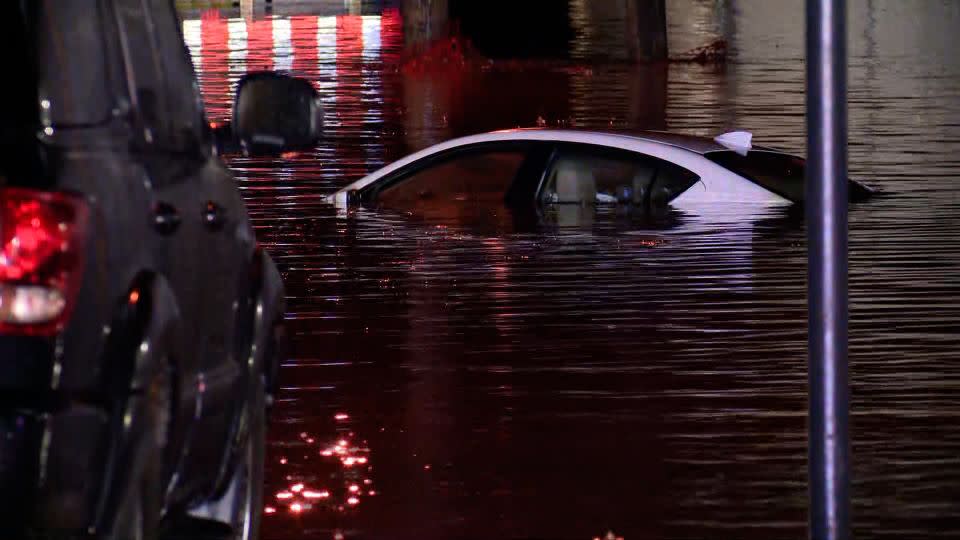Severe storms damage homes, cut off power to thousands of Americans across Ohio Valley
More than a dozen homes were damaged in one West Virginia community and more than 100,000 customers in the state were without power late Tuesday night as a powerful system of thunderstorms with damaging winds, dangerous hail and the potential for destructive tornadoes swept through parts of the Ohio Valley.
At least 13 homes were damaged and some residents were injured, Fayette County, West Virginia, Office of Emergency Management director Kevin Walker told CNN. The injuries were non-life threatening, Walker said.
West Virginia Gov. Jim Justice declared a state of emergency Tuesday for Fayette County, as well as Kanawha, Lincoln and Nicholas counties, saying the storms brought “flooding, downed trees, power outages, and road blockages.”
The storm system left behind a trail of damage in parts of Tennessee, too. In the city of Sunbright, pictures on social media show buildings with their roofs and sides entirely ripped off, and piles of wooden planks and debris littering surrounding streets.
The first of these thunderstorms rumbled to life early Tuesday afternoon in portions of Missouri and Illinois.
The storms pose the most significant threat for tornadoes so far this year, with parts of Ohio, Kentucky and Indiana most at risk. Ohio hasn’t been warned of a tornado threat this substantial in more than 10 years, according to SPC data. It’s in this region where strong tornadoes could form and stay on the ground for several miles at a time.
A tornado watch is in effect until 2 a.m. Wednesday for eastern Kentucky, southeastern Ohio, southwestern Pennsylvania and West Virginia, according to the National Weather Service Storm Prediction Center.
“Severe thunderstorms including a few supercells are expected to steadily spread east-northeastward across the region through evening, including the potential for tornadoes aside from large hail and damaging winds,” the prediction center warned Tuesday.
A first round of damaging storms rolled through the Ohio Valley Tuesday morning and knocked out power to thousands of homes and businesses, according to poweroutage.us. More than 250,000 customers remained in the dark Tuesday night across West Virginia, Wisconsin, Michigan, Ohio and Kentucky – the majority of whom are in West Virginia. Damaging winds of 40 to 60 mph battered much of the region and a 92 mph gust was reported in Huntington, West Virginia.
The Lexington, Kentucky, area saw “significant damage” after storms rolled through early Tuesday, Mayor Linda Gorton said at a press conference.
The damage and the threat of stronger storms to come prompted Kentucky Gov. Andy Beshear to declare a statewide state of emergency Tuesday.
“We need all Kentuckians to stay weather aware as we brace for more severe weather,” Gov. Beshear said in a press release Tuesday.
In southern Indiana, multiple vehicles were flipped over “due to high winds or (a) possible tornado” on Interstate 265, Indiana State Police in Sellersburg said, adding minor injuries were reported.

The same severe weather system tore through the central US on Monday, prompting more than 100 storm reports across the region, including three tornadoes in Oklahoma. Homes were damaged by the storms in Barnsdall, Oklahoma, around 40 miles north of Tulsa, town police told CNN.
“I was on duty and patrolling the streets when it came through,” Barnsdall officer Eric Sofian said. “There was a lot of heavy wind, a lot of lightning and I could see a lot of sparks flying from the power lines.”
Massive hailstones were reported in Texas, including one as large as 4.5 inches in diameter in Briar – bigger than a softball.
The tornado threat will lessen Wednesday as storms shift east, but there is still a Level 2 of 5 risk for severe thunderstorms with damaging winds, hail and even a tornado or two from the mid-Atlantic to Florida.
Significant snow coming
Rain north of the severe weather was forecast to transition to snow and a wintry mix later Tuesday in areas of the Midwest and Great Lakes, and rain and snow showers will continue in parts of both regions through Thursday.
“A burst of heavy, wet snow will lead to travel impacts across parts of NW Illinois for the evening commute,” the National Weather Service Chicago said. “Additional slushy accumulations will occur across the rest of northern/northeast Illinois late tonight and (Wednesday morning).”
The highest snowfall totals are expected across the parts of Michigan and Wisconsin, where snowfall of 6 to 12 inches is possible through Thursday. Snowfall could snarl travel in the region.
Winter-like weather will shift into the interior Northeast beginning Wednesday, where winter storm watches are in effect for much of the interior region into Friday.
The Adirondacks could see up to a foot of snowfall by Thursday, while parts of the Green and White Mountains can see over a foot of snowfall. Gusts up to 50 mph combined with heavy snowfall can cause blowing snow and can cause power outages and travel delays.
Major cities across the Northeast, including New York City, Boston and Philadelphia, are currently forecast to see rain.
CNN’s Amanda Jackson, Amy Simonson and Jeff Winter contributed to this report.
For more CNN news and newsletters create an account at CNN.com

 Yahoo News
Yahoo News 
